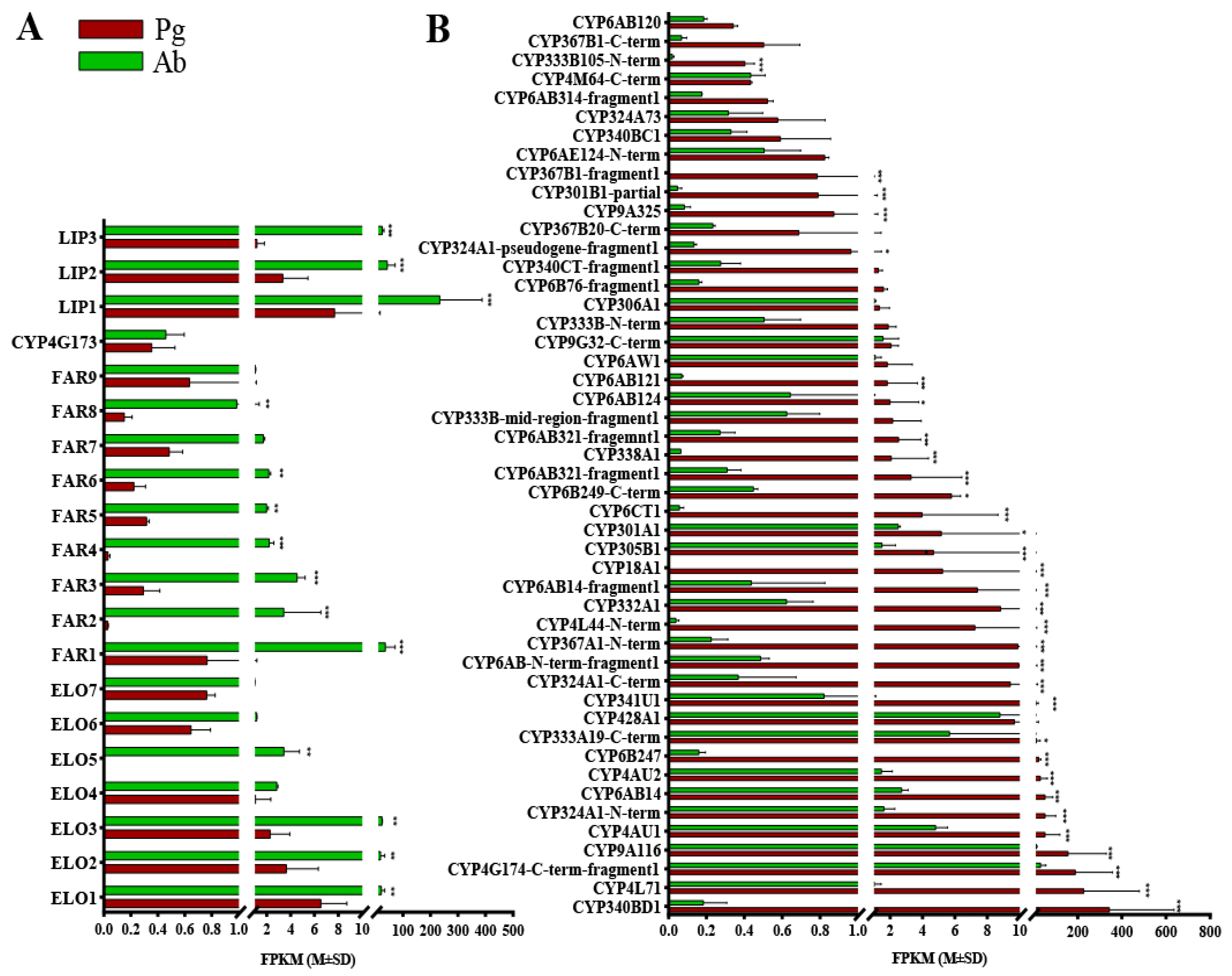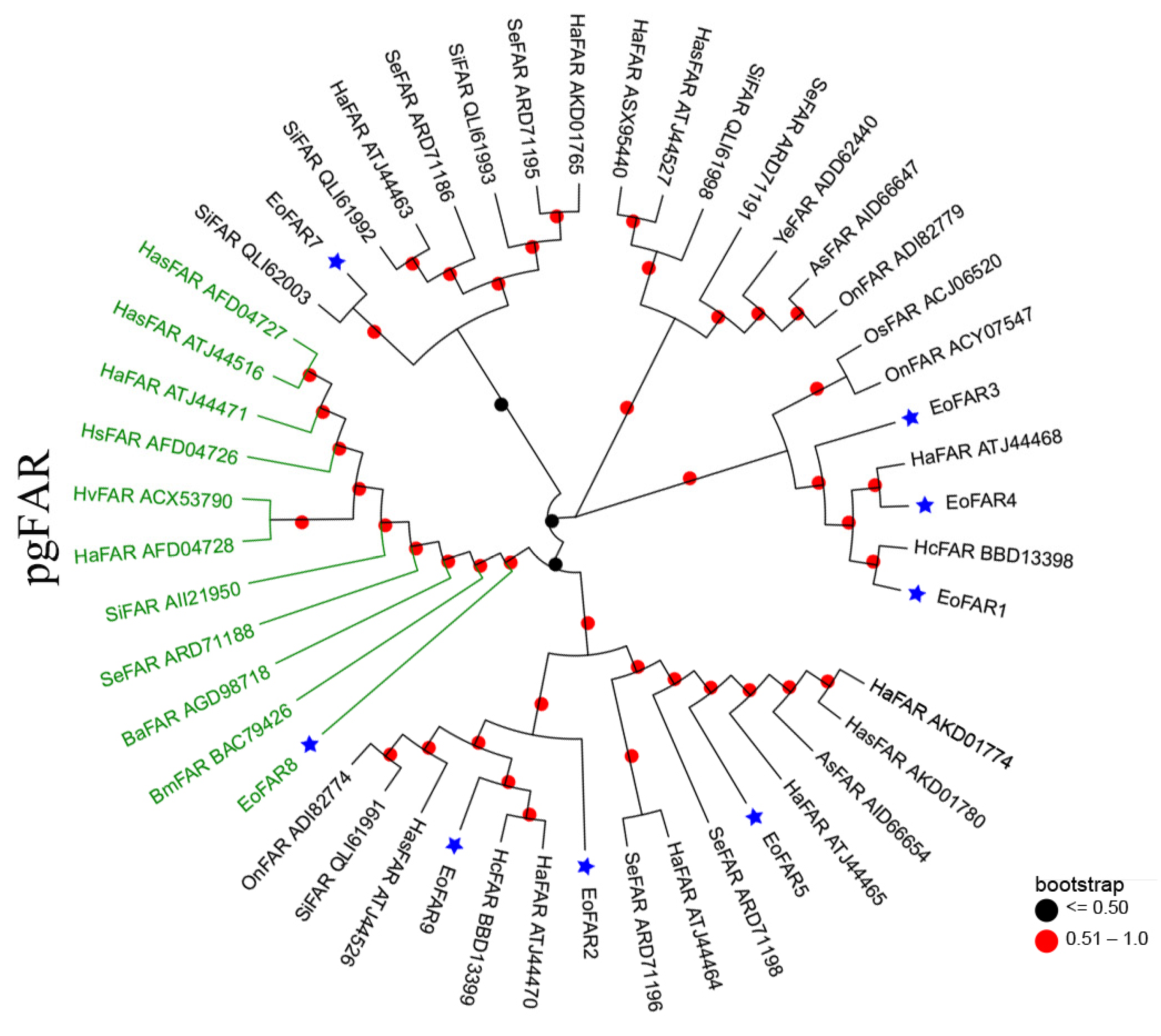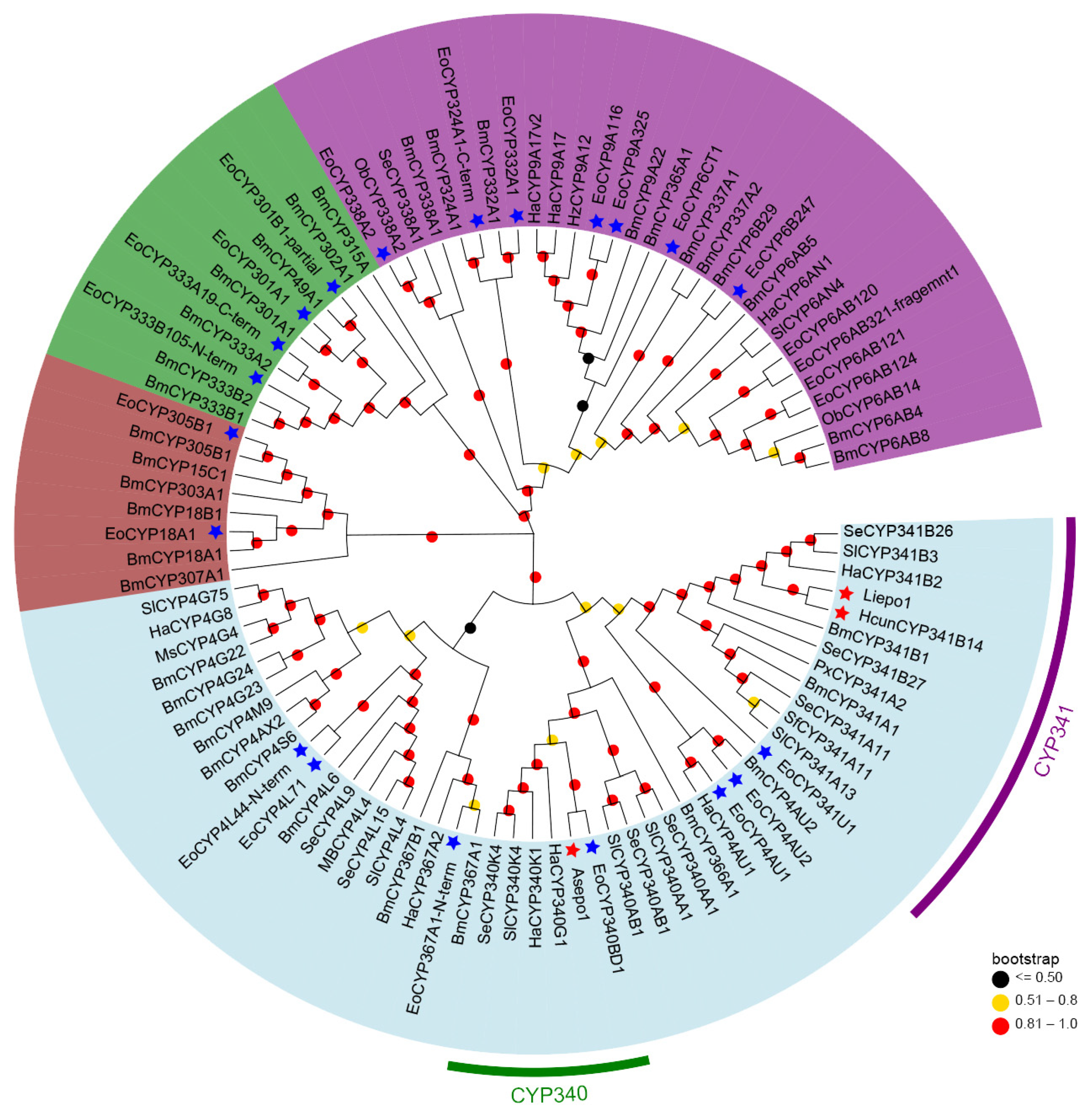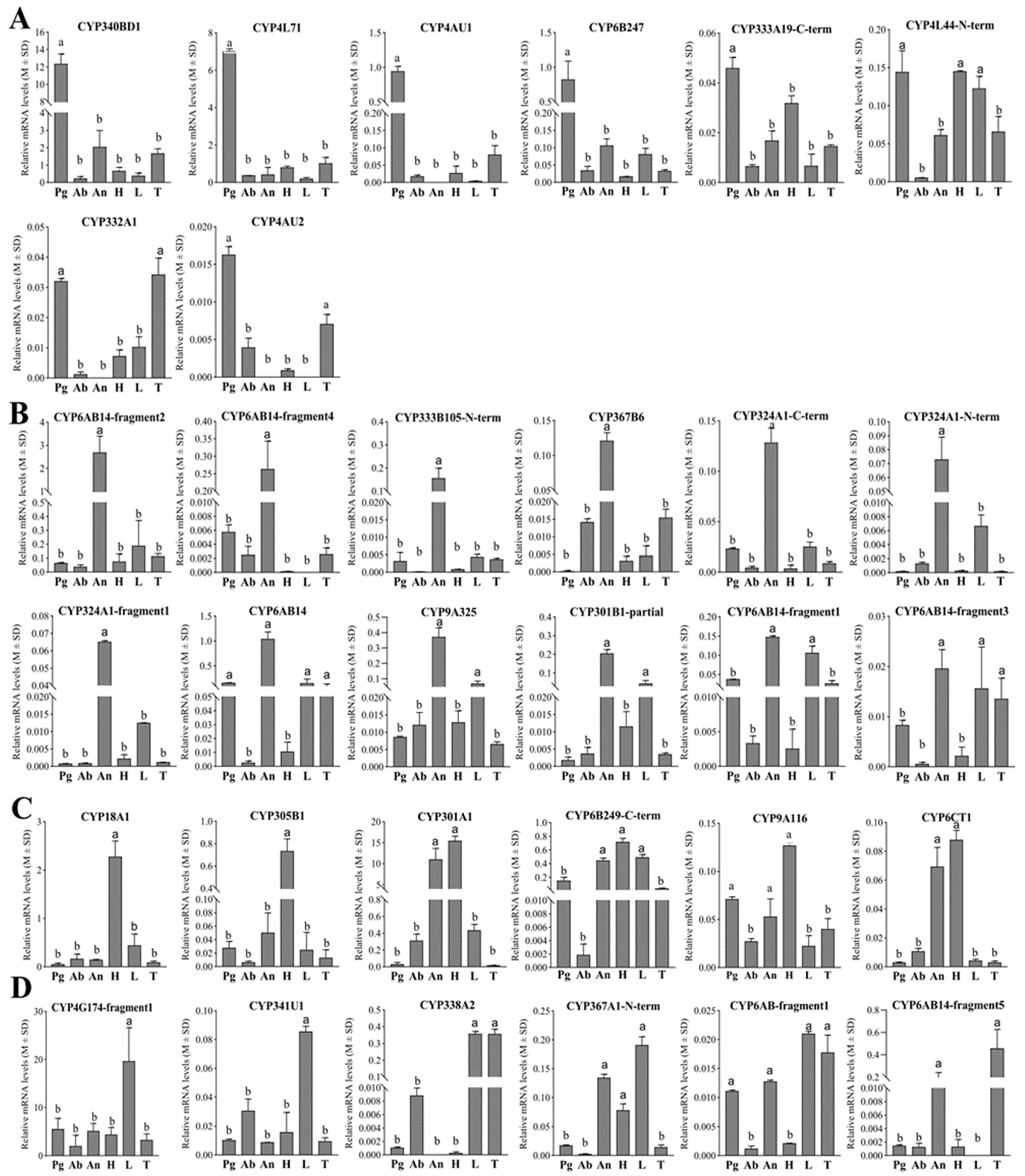Identification of Candidate Genes Associated with Type-II Sex Pheromone Biosynthesis in the Tea Geometrid (Ectropis obliqua) (Lepidoptera: Geometridae)
Abstract
:Simple Summary
Abstract
1. Introduction
2. Materials and Methods
2.1. Insect Rearing and Tissue Collection
2.2. cDNA Library Construction and RNA Sequencing
2.3. De Novo Assembly and Annotation
2.4. Transcript Expression Level Quantification
2.5. Sequence Analysis and Phylogenetic Analysis
2.6. RT-qPCR Analyses
3. Results
3.1. Transcriptomic Sequencing and Functional Annotation of Unigenes
3.2. Identification of Putative Genes Related to Sex Pheromone Biosynthesis
3.3. Phylogenetic Analyses
3.4. Tissue Expression Profiles of Putative Genes Involved in E. obliqua Sex Pheromone Biosynthesis
- Fatty acyl-CoA elongase
- Fatty acyl-CoA reductase
- P450 decarbonylase
- Lipophorin
- Epoxidase
4. Discussion
5. Conclusions
Supplementary Materials
Author Contributions
Funding
Data Availability Statement
Acknowledgments
Conflicts of Interest
References
- Jurenka, R. Insect pheromone biosynthesis. In Chemistry of Pheromones and Other Semiochemicals I; Schulz, S., Ed.; Topics in Current Chemistry-Series; Springer: Berlin/Heidelberg, Germany, 2004; Volume 239, pp. 97–131. [Google Scholar]
- Aguilar, P.; Bourgeois, T.; Maria, A.; Couzi, P.; Demondion, E.; Bozzolan, F.; Gassias, E.; Force, E.; Debernard, S. Methoprene-tolerant and Kruppel homolog 1 are actors of juvenile hormone-signaling controlling the development of male sexual behavior in the moth Agrotis ipsilon. Horm. Behav. 2023, 150, 11. [Google Scholar] [CrossRef] [PubMed]
- Ando, T.; Yamamoto, M. Semiochemicals containing lepidopteran sex pheromones: Wonderland for a natural product chemist. J. Pestic. Sci. 2020, 45, 191–205. [Google Scholar] [CrossRef] [PubMed]
- Petkevicius, K.; Löfstedt, C.; Borodina, I. Insect sex pheromone production in yeasts and plants. Curr. Opin. Biotechnol. 2020, 65, 259–267. [Google Scholar] [CrossRef] [PubMed]
- Zhu, J.W.; Millar, J.; Lofstedt, C. Hormonal-regulation of sex-pheromone biosynthesis in the turnip moth, Agrotis segetum. Arch. Insect Biochem. Physiol. 1995, 30, 41–59. [Google Scholar] [CrossRef]
- Wang, H.L.; Zhao, C.H.; Szöcs, G.; Chinta, S.P.; Schulz, S.; Löfstedt, C. Biosynthesis and PBAN-regulated transport of pheromone polyenes in the winter moth, Operophtera brumata. J. Chem. Ecol. 2013, 39, 790–796. [Google Scholar] [CrossRef]
- Kiyota, R.; Arakawa, M.; Yamakawa, R.; Yasmin, A.; Ando, T. Biosynthetic pathways of the sex pheromone components and substrate selectivity of the oxidation enzymes working in pheromone glands of the fall webworm, Hyphantria cunea. Insect Biochem. Mol. Biol. 2011, 41, 362–369. [Google Scholar] [CrossRef]
- Ding, B.J.; Liénard, M.A.; Wang, H.L.; Zhao, C.H.; Löfstedt, C. Terminal fatty-acyl-CoA desaturase involved in sex pheromone biosynthesis in the winter moth (Operophtera brumata). Insect Biochem. Mol. Biol. 2011, 41, 715–722. [Google Scholar] [CrossRef]
- Wei, W.; Miyamoto, T.; Endo, M.; Murakawa, T.; Pu, G.Q.; Ando, T. Polyunsaturated hydrocarbons in the hemolymph: Biosynthetic precursors of epoxy pheromones of geometrid and arctiid moths. Insect Biochem. Mol. Biol. 2003, 33, 397–405. [Google Scholar] [CrossRef] [PubMed]
- Goller, S.; Szöcs, G.; Francke, W.; Schulz, S. Biosynthesis of (3Z,6Z,9Z)-3,6,9-Octadecatriene: The main component of the pheromone blend of Erannis bajaria. J. Chem. Ecol. 2007, 33, 1505–1509. [Google Scholar] [CrossRef]
- Blomquist, G.J.; Ginzel, M.D. Chemical ecology, biochemistry, and molecular biology of insect hydrocarbons. Annu. Rev. Entomol. 2021, 66, 45–60. [Google Scholar] [CrossRef]
- Grigoraki, L.; Grau-Bové, X.; Carrington Yates, H.; Lycett, G.J.; Ranson, H. Isolation and transcriptomic analysis of Anopheles gambiae oenocytes enables the delineation of hydrocarbon biosynthesis. eLife 2020, 9, e58019. [Google Scholar] [CrossRef]
- Schal, C.; Sevala, V.; Cardé, R.T. Novel and highly specific transport of a volatile sex pheromone by hemolymph lipophorin in moths. Naturwissenschaften 1998, 85, 339–342. [Google Scholar] [CrossRef]
- Matsuoka, K.; Tabunoki, H.; Kawai, T.; Ishikawa, S.; Yamamoto, M.; Sato, R.; Ando, T. Transport of a hydrophobic biosynthetic precursor by lipophorin in the hemolymph of a geometrid female moth which secretes an epoxyalkenyl sex pheromone. Insect Biochem. Mol. Biol. 2006, 36, 576–583. [Google Scholar] [CrossRef]
- Rong, Y.; Fujii, T.; Ishikawa, Y. CYPs in different families are involved in the divergent regio-specific epoxidation of alkenyl sex pheromone precursors in moths. Insect Biochem. Mol. Biol. 2019, 108, 9–15. [Google Scholar] [CrossRef]
- Rong, Y.; Fujii, T.; Naka, H.; Yamamoto, M.; Ishikawa, Y. Functional characterization of the epoxidase gene, Li_epo1 (CYP341B14), involved in generation of epoxyalkene pheromones in the mulberry tiger moth Lemyra imparilis. Insect Biochem. Mol. Biol. 2019, 107, 46–52. [Google Scholar] [CrossRef] [PubMed]
- Rong, Y.; Fujii, T.; Katsuma, S.; Yamamoto, M.; Ando, T.; Ishikawa, Y. CYP341B14: A cytochrome P450 involved in the specific epoxidation of pheromone precursors in the fall webworm Hyphantria cunea. Insect Biochem. Mol. Biol. 2014, 54, 122–128. [Google Scholar] [CrossRef] [PubMed]
- Li, Z.Q.; Cai, X.M.; Luo, Z.X.; Bian, L.; Xin, Z.J.; Chu, B.; Liu, Y.; Chen, Z.M. Comparison of olfactory genes in two Ectropis species: Emphasis on candidates involved in the detection of Type-II sex pheromones. Front. Physiol. 2018, 9, 13. [Google Scholar] [CrossRef]
- Ya-Nan, Z.; Xiu-Yun, Z.; Li-Ping, F.; Peng, H.; Zhi-Qiang, W.; Geng, C.; Liang, S.; Zhan-Feng, Y.; Dao-Gui, D.; Jin-Bu, L. Identification and expression profiles of sex pheromone biosynthesis and transport related genes in Spodoptera litura. PLoS ONE 2015, 10, e0140019. [Google Scholar]
- Grabherr, M.G.; Haas, B.J.; Yassour, M.; Levin, J.Z.; Thompson, D.A.; Amit, I.; Adiconis, X.; Fan, L.; Raychowdhury, R.; Zeng, Q.; et al. Full-length transcriptome assembly from RNA-Seq data without a reference genome. Nat. Biotechnol. 2011, 29, 644–652. [Google Scholar] [CrossRef]
- Kumar, S.; Stecher, G.; Tamura, K. MEGA7: Molecular evolutionary genetics analysis version 7.0 for bigger datasets. Mol. Biol. Evol. 2016, 33, 1870–1874. [Google Scholar] [CrossRef]
- Wang, T.; Liu, X.; Luo, Z.; Cai, X.; Li, Z.; Bian, L.; Xiu, C.; Chen, Z.; Li, Q.; Fu, N. Transcriptome-wide identification of cytochrome P450s in tea black tussock moth (Dasychira baibarana) and candidate genes involved in Type-II sex pheromone biosynthesis. Insects 2024, 15, 139. [Google Scholar] [CrossRef]
- Yuan, T.-T.; Luo, Z.-J.; Luo, Z.-X.; Cai, X.-M.; Bian, L.; Xiu, C.-L.; Fu, N.-X.; Chen, Z.-M.; Zhang, L.-W.; Li, Z.-Q. Olfactory gene families in Scopula subpunctaria and candidates for Type-II sex pheromone detection. Int. J. Mol. Sci. 2022, 23, 15775. [Google Scholar] [CrossRef] [PubMed]
- Bustin, S.A.; Vandesompele, J.; Pfaffl, M.W. Standardization of qPCR and RT-qPCR. Genet. Eng. Biotechnol. News 2009, 29, 40–43. [Google Scholar]
- Livak, K.J.; Schmittgen, T.D. Analysis of relative gene expression data using real-time quantitative PCR and the 2−ΔΔCT method. Methods 2001, 25, 402–408. [Google Scholar] [CrossRef] [PubMed]
- Qiu, Y.; Tittiger, C.; Wicker-Thomas, C.; Le Goff, G.; Young, S.; Wajnberg, E.; Fricaux, T.; Taquet, N.; Blomquist, G.J.; Feyereisen, R. An insect-specific P450 oxidative decarbonylase for cuticular hydrocarbon biosynthesis. Proc. Natl. Acad. Sci. USA 2012, 109, 14858–14863. [Google Scholar] [CrossRef]
- Nuo, S.M.; Yang, A.J.; Li, G.C.; Xiao, H.Y.; Liu, N.Y. Transcriptome analysis identifies candidate genes in the biosynthetic pathway of sex pheromones from a zygaenid moth, Achelura yunnanensis (Lepidoptera: Zygaenidae). PeerJ 2021, 9, e12641. [Google Scholar] [CrossRef] [PubMed]
- Millar, J.G. Polyene hydrocarbons and epoxides: A second major class of lepidopteran sex attractant pheromones. Annu. Rev. Entomol. 2000, 45, 575–604. [Google Scholar] [CrossRef]
- Luo, Z.X.; Li, Z.Q.; Cai, X.M.; Bian, L.; Chen, Z.M. Evidence of premating isolation between two sibling moths: Ectropis grisescens and Ectropis obliqua (Lepidoptera: Geometridae). J. Econ. Entomol. 2017, 110, 2364–2370. [Google Scholar] [CrossRef] [PubMed]
- Holze, H.; Schrader, L.; Buellesbach, J. Advances in deciphering the genetic basis of insect cuticular hydrocarbon biosynthesis and variation. Heredity 2021, 126, 219–234. [Google Scholar] [CrossRef]
- Moris, V.C.; Podsiadlowski, L.; Martin, S.; Oeyen, J.P.; Donath, A.; Petersen, M.; Wilbrandt, J.; Misof, B.; Liedtke, D.; Thamm, M.; et al. Intrasexual cuticular hydrocarbon dimorphism in a wasp sheds light on hydrocarbon biosynthesis genes in Hymenoptera. Commun. Biol. 2023, 6, 15. [Google Scholar] [CrossRef]
- Chertemps, T.; Duportets, L.; Labeur, C.; Ueda, R.; Takahashi, K.; Saigo, K.; Wicker-Thomas, C. A female-biased expressed elongase involved in long-chain hydrocarbon biosynthesis and courtship behavior in Drosophila melanogaster. Proc. Natl. Acad. Sci. USA 2007, 104, 4273–4278. [Google Scholar] [CrossRef] [PubMed]
- Carot-Sans, G.; Muñoz, L.; Piulachs, M.D.; Guerrero, A.; Rosell, G. Identification and characterization of a fatty acyl reductase from a Spodoptera littoralis female gland involved in pheromone biosynthesis. Insect Mol. Biol. 2015, 24, 82–92. [Google Scholar] [CrossRef] [PubMed]
- Tupec, M.; Bucek, A.; Valterová, I.; Pichová, I. Biotechnological potential of insect fatty acid-modifying enzymes. Z. Naturforsch. C 2017, 72, 387–403. [Google Scholar] [CrossRef] [PubMed]
- Antony, B.; Ding, B.-J.; Moto, K.I.; Aldosari, S.A.; Aldawood, A.S. Two fatty acyl reductases involved in moth pheromone biosynthesis. Sci. Rep 2016, 6, 29927. [Google Scholar] [CrossRef] [PubMed]
- Sun, Y.; Gong, Y.; He, Q.; Kuang, S.; Gao, Q.; Ding, W.; He, H.; Xue, J.; Li, Y.; Qiu, L. FAR knockout significantly inhibits Chilo suppressalis survival and transgene expression of double-stranded FAR in rice exhibits strong pest resistance. Plant Biotechnol. J. 2022, 20, 2272–2283. [Google Scholar] [CrossRef] [PubMed]
- Moto, K.; Yoshiga, T.; Yamamoto, M.; Takahashi, S.; Okano, K.; Ando, T.; Nakata, T.; Matsumoto, S. Pheromone gland-specific fatty-acyl reductase of the silkmoth, Bombyx mori. Proc. Natl. Acad. Sci. USA 2003, 100, 9156–9161. [Google Scholar] [CrossRef] [PubMed]
- Rooney, A.P. Pheromone emergencies and drifting moth genomes. Proc. Natl. Acad. Sci. USA 2011, 108, 8069–8070. [Google Scholar] [CrossRef]
- Matsunaga, I.; Yokotani, N.; Gotoh, O.; Kusunose, E.; Yamada, M.; Ichihara, K. Molecular cloning and expression of fatty acid alpha-hydroxylase from Sphingomonas paucimobilis. J. Biol. Chem. 1997, 272, 23592–23596. [Google Scholar] [CrossRef]





| Statistics | Data |
|---|---|
| Total unigene number | 46,202 |
| Total unigene length | 48,016,811 |
| Total transcript number | 88,962 |
| Total transcript length | 110,465,377 |
| Average length | 1039 |
| Largest unigene | 28,733 |
| NR-annotated unigenes | 17,683 |
| GO-annotated unigenes | 7499 |
| COG-annotated unigenes | 13,283 |
| KEGG-annotated unigenes | 7499 |
| SWSS-annotated unigenes | 9435 |
Disclaimer/Publisher’s Note: The statements, opinions and data contained in all publications are solely those of the individual author(s) and contributor(s) and not of MDPI and/or the editor(s). MDPI and/or the editor(s) disclaim responsibility for any injury to people or property resulting from any ideas, methods, instructions or products referred to in the content. |
© 2024 by the authors. Licensee MDPI, Basel, Switzerland. This article is an open access article distributed under the terms and conditions of the Creative Commons Attribution (CC BY) license (https://creativecommons.org/licenses/by/4.0/).
Share and Cite
Xu, C.; Fu, N.; Cai, X.; Li, Z.; Bian, L.; Xiu, C.; Chen, Z.; Ma, L.; Luo, Z. Identification of Candidate Genes Associated with Type-II Sex Pheromone Biosynthesis in the Tea Geometrid (Ectropis obliqua) (Lepidoptera: Geometridae). Insects 2024, 15, 276. https://doi.org/10.3390/insects15040276
Xu C, Fu N, Cai X, Li Z, Bian L, Xiu C, Chen Z, Ma L, Luo Z. Identification of Candidate Genes Associated with Type-II Sex Pheromone Biosynthesis in the Tea Geometrid (Ectropis obliqua) (Lepidoptera: Geometridae). Insects. 2024; 15(4):276. https://doi.org/10.3390/insects15040276
Chicago/Turabian StyleXu, Changxia, Nanxia Fu, Xiaoming Cai, Zhaoqun Li, Lei Bian, Chunli Xiu, Zongmao Chen, Long Ma, and Zongxiu Luo. 2024. "Identification of Candidate Genes Associated with Type-II Sex Pheromone Biosynthesis in the Tea Geometrid (Ectropis obliqua) (Lepidoptera: Geometridae)" Insects 15, no. 4: 276. https://doi.org/10.3390/insects15040276






